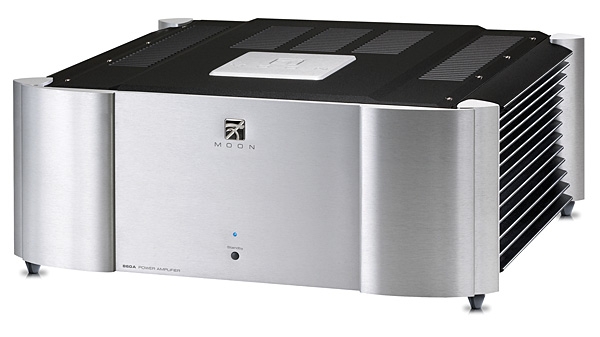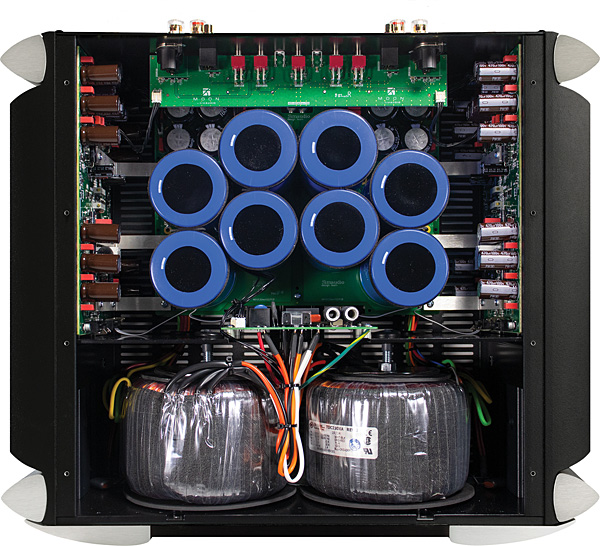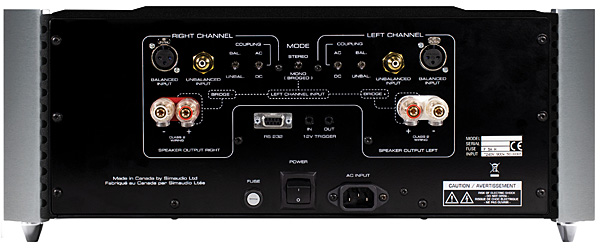| Columns Retired Columns & Blogs |
Sadly, Monsieur Lemire passed away on September 23rd at age 55.
https://simaudio.com/en/moon-is-grieving/
The last sentence of the review looks incomplete.

This tale of altered expectations began a few years after my birth, at AXPONA 2022, where I covered several stellar-sounding rooms that included Simaudio Moon electronics. By the third such room, I'd resolved to contact Simaudio, check in with Jim Austin, and see if there was a product that made sense to review in my system.
Simaudio co-owner Costa Koulisakis proposed I review two Moon 860A v2 power amplifiers ($20,000 each), which can be used as monoblocks. I agreed. Jim approved. Then, when Costa arrived to help install them in my music room, he told me they'd received only 200 of the 400 hours of requisite break-in time. On top of that, they'd arrived cold and needed three days of continual run-in to come up to speed—or, rather, temperature.
I heard his words, but I didn't know how they would translate into sound. And because Stereophile reviewers never share their listening impressions with manufacturers or their representatives while a product is under review (unless something is obviously broken), I kept a straight face when I heard a shallow, undistinguished midrange and harsh, disturbing top end that portended a month of misery.
Twelve hours after I'd begun playing files on repeat—and after Costa had departed—friend Scott arrived for a listen. As we entered the music room, François-Xavier Roth and Les Siècles' unique instruments-of-the-period recording of Mahler's Symphony No.4 (24/96 WAV, files supplied by Harmonia Mundi) was filling the space. I engaged the Stromtank S 1000 battery power source, which powers everything but the amps, and we sat down to listen to the third-movement adagio.
Rarely have I transitioned so quickly from "Play" to meditative silence. As my body relaxed, an alternative universe unfolded before and around me, and I was transported into the heart of Mahler through the lens of Roth's intentions. Every instrument seemed to sing in summer's light. Every line, note, and transition conveyed beauty and wonder. I felt like a child discovering for the first time the miracle of dew on blades of grass glowing under the morning sun, or butterflies whirling in the sky above. I could scarcely believe all this beauty was mine to enjoy and cherish. To say I was high on sound would be an understatement. Was this what my next month of listening would be like?
Listening to what, by whom?
Moon by Simaudio, Ltd., of Québec, Canada, was founded in 1980 by Victor Sima as Sima Electronique. In the 1990s, the Sima brand morphed into the Celeste brand until, in 1997, the Moon brand prevailed (footnote 1).
When Sima employee Jean Poulin bought the small company in 1993, there was only one engineer, Thierry Dufour. Upon Poulin's retirement in 2013, Dufour, now chief engineer, bought the company with two partners, Costa Koulisakis (the self-described "face" of Simaudio and their director of training) and electrical engineer Louis Lemire.
Today, Simaudio has 62 employees including 10 engineers. The company sells its products in 42 countries: Its most active markets are the US, Canada, mainland China, Hong Kong, the UK, Germany, and France. Everything is manufactured at the factory in Boucherville, Québec.
Despite the amplifier's "v2" designation, only its case resembles its predecessor's. On the inside, the 860A v2 is transformed, a trickle-down relative of the top-line statement 888 monoblocks (approx. $120,000/pair).
"We made the 888 to show the world what we can do," Costa explained as he sat in my music room. "The 860A v2 borrows technology from the larger amp and has virtually nothing in common with the original 860A.
"When operated in monaural mode, the amp has a fully dual-monaural power supply with one power supply per phase. You cannot get more separate than that." In stereo mode, it outputs 225Wpc into 8 ohms and doubles its power with every halving of impedance down to 2 ohms. If used as a monoblock (as I used it), each amp outputs 750W into 8 ohms, 1500W into 4 ohms. The 860A v2 isn't rated into 2 ohms—household-current limitations keep it from doubling into 2 ohms—but it is "more than up to the task" of driving a 2 ohm load, Costa said. Mono or stereo, this class-AB design runs class-A for the first 5W, presumably into 8 ohms.
The 860A v2's transformer design is new, employing design elements borrowed from the medical field. The large power supply contains caps made to Simaudio's specifications. "We use ultralow ESR capacitors [footnote 2] and proprietary high-current bipolar output transistors, very tightly matched, that are custom manufactured for us by Onsemi," Costa said. "In each amplifier, there are 24 hand-matched 250W output transistors in parallel. The amp's enormous power supply"—or should that be plural?—"can support unrestricted power into lower impedances. Combined with the huge energy storage of over 275,000ÊF in total per amplifier, you have massive power reserves available. Every output transistor is accompanied by additional power supply storage; this enables the amp to amplify high-frequency transients with greater snappiness and detail. You'll never use all that power, but the huge headroom it supplies contributes to greater clarity and instrumental focus."

The 860A v2 does not use a global feedback loop. "In a theoretically perfect amplifier, which obviously does not exist, the only difference in the audio signal at the input and output should be its amplitude," Costa said. "But as the signal is processed and gets amplified little by little as it goes through the gain stages—as every device imparts its sonic character on the signal and influences it—it gets distorted a bit.
"A global feedback loop takes the signal at the output, feeds it all the way back to the input, and does a comparison. Doing so inverts the signal and cancels out distortion. The more feedback you apply, the more you can reduce distortion. But constantly looping the signal back also subjectively slows down the amplifier. It creates a coloration that can alter detail and speed, masking fine, low-level information that is critical to recreating a sense of space in music. A global feedback loop usually produces a thicker sound and, sometimes, even a punchier sound—it usually provides better distortion figures on paper—but you may lose a bit of detail.
"When you remove the global feedback loop, the amplifier no longer has a way of reducing distortion levels that can affect stability. Only a handful of companies have eliminated global feedback, and each implementation is different. We've continually refined our implementation of zero global feedback since we launched a preamp of this design in 1986.
"With no global feedback, we amplify high frequencies snappily and quickly. Our amplifier design produces a cleaner signal and you get more musical detail. We have local feedback loops, but they are not harmful to sound quality."
In previous Moon amplifiers, two boards sat back to back, one atop the other, with signal paths kept short. The 888 and the 860A v2 place one densely packed, four-layer board on each side of the amp, pressed against heatsinks composed of aircraft-grade aluminum. Signal paths are even shorter. Thermal stability, which enables semiconductors to perform optimally, is maintained within a narrow temperature range by proximity to the heatsinks. "Parts matching goes for naught if semiconductors operate at very different temperatures," Costa declared.
When the 860A v2 performs as a monoblock, it employs a unique, passive bridging circuit designed to maintain sonic accuracy. "To bridge an amplifier into mono and get it to sound better, you must have a power supply adequate to support it," Costa said. "Otherwise, power will sag. In theory, if your implementation is correct, you should get 6dB more gain. That equals four times more power. But in practice, it is impossible to realize that much power due to inefficiencies and losses. Our circuit implementation and power supply together deliver near the theoretical additional 6dB of power with all the extra dynamics and no loss in sound quality."
In a follow-up summary, Costa wrote, "Many audiophiles believe, and correctly so, that bridging an amplifier brings about more power at the expense of sound quality. This is true for most stereo amplifiers that have power supply and bridging-circuit limitations. It is not true for the 860A v2; it gives you even better, fully balanced performance in monaural mode than in stereo.

"When you run an amp into mono, you traditionally use the left-channel input. That input has to go through a differential circuit that is often destructive to sound quality. Since most stereo amps are never bridged, the quality of this input circuitry is often an afterthought. But because we begin with a larger power supply and balanced circuits, we succeed. Listening tests reveal that mono mode increases dynamics and fine detail retrieval and delivers a smoother, more effortless character at all volume levels."
The 860A v2 is DC-coupled, with no capacitors or other filtering in the signal path. Theoretically, this allows frequency response to descend almost to 0Hz. According to Costa, "The sonic benefits of DC coupling include less phase shift at all frequencies, particularly lower ones, permitting a finer focus of instruments and vocals, as well as more neutrality and harmonically accurate bass reproduction."
AC coupling, which places a capacitor in the signal path—a capacitor Costa claims will induce a phase shift and truncate bass extension—prevents any possibility of amplifying DC offset, which could cause a loudspeaker to blow.
To protect against the DC offset that sometimes occurs with older preamps, the 860A v2 employs a servo monitoring circuit. If DC is below a certain threshold, the servo circuit pads it to zero; if it's above the threshold, a microcontroller places the amp into protection mode and shuts it down. Flashing LEDs indicate if the problem is excess DC or excess heat. If the amp keeps shutting down, users can flick a rear panel switch and shift from the default DC setting to AC. Additional diagnostic tools can help isolate the problem.
Costa touted the 860A v2's high damping factor—1000—and its low output impedance (footnote 3). "This increases the amplifier's ability to grab hold of and control the motion of speaker diaphragms and makes it sonically more compatible with long cable runs. High damping factor plus zero global feedback produces very tight bass that is quick and accurate."
I asked Costa what he and his designers hoped to achieve with the 860A v2. He replied, "The least coloration possible. It's like a ride in a Ferrari: Any low-level information we can retrieve, we let you hear. Some other amps are more like a ride in a Rolls-Royce that masks the irregularities in the surface you're driving on. Whether the recording is good or not, it always sounds enjoyable. But that's not Moon. We do not mask anything. We aim for revealing."
And then
Given such a long technical explanation, the last thing anyone needs is an exhausting accounting of every switch on the 860A v2's front and rear panels. If you want to know more than is obvious from the photos provided with this review, cruise on over to the Simaudio website; there's even the manual online (footnote 4).
The 860A v2s arrived one day after the last in a month-long series of system changes. First, the dCS Rossini Apex raised the sound bar (not soundbar) to an entirely new level. Then more Wilson Audio Pedestals helped improve tonal balance, air, and control. Next, the Nordost QNet and QSource Ethernet switch amd linear power supply allowed me to radically simplify and improve streaming/file playback. Relocating several pieces of equipment further blackened backgrounds, and a second QSource expanded my soundstage—icing on an already rich cake.
Footnote 2: Low-ESR capacitors have less internal resistance, so less power is wasted as heat.
Footnote 3: Simaudio doesn't specify the output impedance, but if the damping factor is determined relative to a nominal 8 ohms, then it must be 0.008 ohm.
Footnote 4: See simaudio.com/wp-content/uploads/2018/03/20210413_860A_v2_Manual_EN.pdf.

Sadly, Monsieur Lemire passed away on September 23rd at age 55.
https://simaudio.com/en/moon-is-grieving/
The last sentence of the review looks incomplete.

I am so sorry for your loss. It is ours as well. Thank you for bringing this to our attention. FYI, Louis Lemire left us over a year ago, in 2021.
From Warsaw, where I'm covering the audio show, I've requested a fix to the last sentence. It was intended to trail off. The last paragraph should read:
As with everything in life, there's always more to be had, always more to want. But when amplifiers already deliver all you need...

" "We made the 888 to show the world what we can do," Costa explained as he sat in my music room. "
No simaudio didn't. They created the 888 amp with the intention to target the high end market in China. Hence the choice of name. 8 is a lucky number over there.